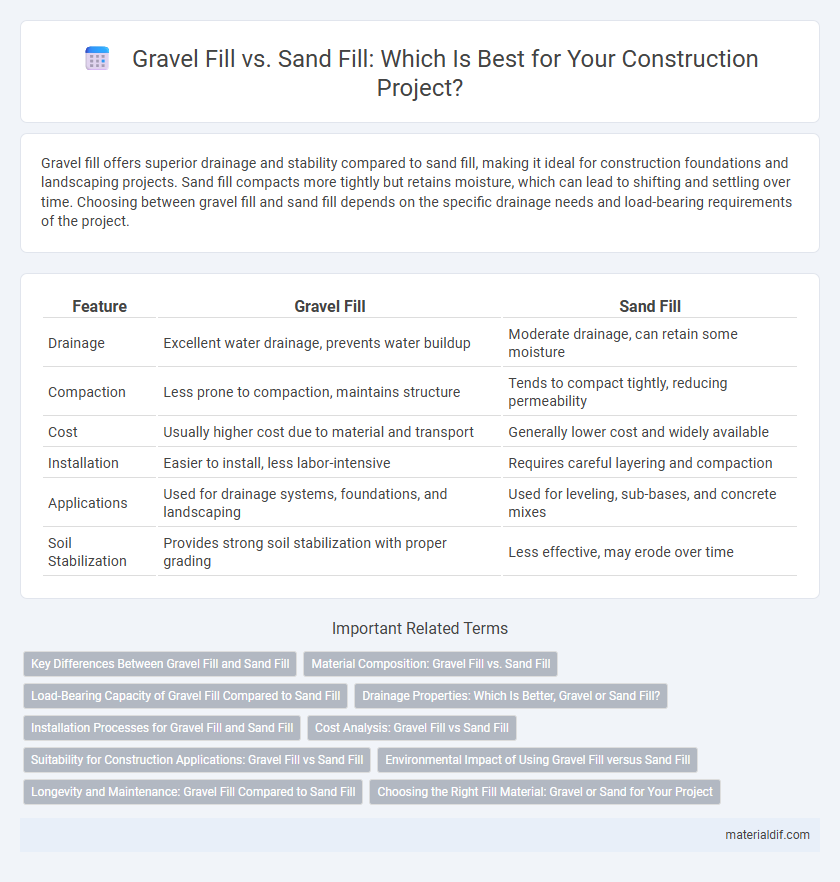Gravel fill offers superior drainage and stability compared to sand fill, making it ideal for construction foundations and landscaping projects. Sand fill compacts more tightly but retains moisture, which can lead to shifting and settling over time. Choosing between gravel fill and sand fill depends on the specific drainage needs and load-bearing requirements of the project.
Table of Comparison
| Feature | Gravel Fill | Sand Fill |
|---|---|---|
| Drainage | Excellent water drainage, prevents water buildup | Moderate drainage, can retain some moisture |
| Compaction | Less prone to compaction, maintains structure | Tends to compact tightly, reducing permeability |
| Cost | Usually higher cost due to material and transport | Generally lower cost and widely available |
| Installation | Easier to install, less labor-intensive | Requires careful layering and compaction |
| Applications | Used for drainage systems, foundations, and landscaping | Used for leveling, sub-bases, and concrete mixes |
| Soil Stabilization | Provides strong soil stabilization with proper grading | Less effective, may erode over time |
Key Differences Between Gravel Fill and Sand Fill
Gravel fill consists of coarse, angular stones that provide excellent drainage and structural stability, making it ideal for foundations and road bases. Sand fill features fine, granular particles that compact tightly, offering superior support in landscaping and concrete mixing but poorer drainage compared to gravel. The primary difference lies in particle size and compaction properties, where gravel promotes water flow and load distribution, while sand creates a denser, more stable surface.
Material Composition: Gravel Fill vs. Sand Fill
Gravel fill consists of coarse, angular rock fragments typically ranging from 2mm to 64mm in size, providing excellent drainage and structural support due to its larger particle size and void spaces. In contrast, sand fill is composed of finer particles, usually between 0.06mm and 2mm, creating a denser and more compact material that retains moisture but has lower permeability. The material composition influences load-bearing capacity, water drainage, and suitability for construction or landscaping projects.
Load-Bearing Capacity of Gravel Fill Compared to Sand Fill
Gravel fill exhibits a higher load-bearing capacity compared to sand fill due to its larger particle size and angular shape, which provide better interlocking and stability under pressure. This results in improved compaction and reduced settlement, making gravel fill ideal for supporting heavy structures such as foundations and roadbeds. The superior drainage properties of gravel also minimize water retention, further enhancing its load-bearing performance over sand fill.
Drainage Properties: Which Is Better, Gravel or Sand Fill?
Gravel fill offers superior drainage properties compared to sand fill due to its larger particle size and higher permeability, allowing water to flow through quickly and reducing the risk of waterlogging. Sand fill tends to retain water because of its finer particles, leading to slower drainage and potential drainage system blockages. For applications requiring efficient water runoff and prevention of soil erosion, gravel fill is the preferred choice.
Installation Processes for Gravel Fill and Sand Fill
Gravel fill installation involves layering coarse aggregates that provide superior drainage and compaction, often requiring a geotextile fabric to separate soil and gravel layers for stability. Sand fill installation demands careful moisture conditioning and compaction in thin lifts to avoid settling and maintain structural integrity. Both processes require heavy machinery for grading, but gravel is typically quicker to install due to larger particle size and better load distribution.
Cost Analysis: Gravel Fill vs Sand Fill
Gravel fill typically costs between $15 to $75 per cubic yard, while sand fill ranges from $10 to $50 per cubic yard, making sand generally more affordable for large-scale projects. Gravel's higher cost is attributed to its superior drainage properties and compaction strength, which can reduce long-term maintenance expenses. Evaluating overall project budgets requires balancing initial material costs against performance benefits, with gravel often preferred for foundational stability despite higher upfront investment.
Suitability for Construction Applications: Gravel Fill vs Sand Fill
Gravel fill offers superior drainage and compaction properties, making it ideal for foundational layers in construction projects where load-bearing capacity is critical. Sand fill provides better gradation and fine particle distribution, suitable for leveling surfaces and reducing settlement in non-structural applications. Selecting between gravel and sand fill depends on specific construction requirements such as drainage needs, load support, and soil stability.
Environmental Impact of Using Gravel Fill versus Sand Fill
Gravel fill has a lower environmental impact compared to sand fill due to its ability to promote better drainage and reduce erosion, thereby minimizing soil degradation and water contamination. Extracting gravel typically disturbs less land area than sand mining, which often leads to habitat destruction and increased turbidity in water bodies. Using gravel fill also supports sustainable construction by reducing reliance on fine sand resources, which are becoming increasingly scarce and environmentally detrimental when overexploited.
Longevity and Maintenance: Gravel Fill Compared to Sand Fill
Gravel fill demonstrates superior longevity due to its excellent drainage properties, reducing the risk of water accumulation and subsequent material degradation compared to sand fill. Maintenance requirements are lower for gravel, as it resists compaction and erosion better than sand, minimizing the need for frequent replenishment or leveling. The durability of gravel fill enhances structural stability, making it a preferred choice for long-term applications in construction and landscaping.
Choosing the Right Fill Material: Gravel or Sand for Your Project
Gravel fill provides superior drainage and stability, making it ideal for foundations, driveways, and landscaping projects requiring robust support and water flow management. Sand fill offers excellent compaction and smoothness, suitable for leveling surfaces and filling gaps in paving or construction where fine texture is necessary. Assess the project's load-bearing needs, drainage requirements, and surface finish preferences to select between gravel and sand fill effectively.
Gravel Fill vs Sand Fill Infographic

 materialdif.com
materialdif.com